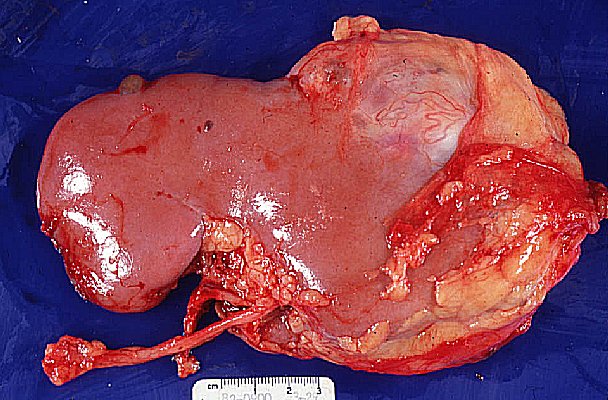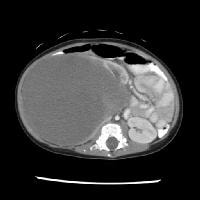Neoplastic Disease-
-Bladder Carcinoma-
-Bladder carcinoma is the most common malignancy of the genitourinary system
-Transitional cell carcinoma is the most most common histologic type
-Bladder cancer ranges from superficial (not involving the muscle), to muscle invasive, and metastatic disease
-Bladder cancer typically presents with painless hematuria
-Bladder cancer can have frequency, urgency and dysuria
-Pain associated with bladder cancer is usually associated with locally advanced metastatic tumor
-Physical exam is usually unremarkable but may feel pelvic mass in patients with advanced metastatic disease
-Workup should include cystoscopy, urinalysis, and urine cytology. CT scan of abdomen and pelvis to evaluate the collecting system and the renal cortex
-Tumors are staged with TMN system
-Bladder cancer can be treated with surgery and/or chemotherapy
-Prostate Carcinoma-
-Prostate cancer is the second most common cancer in men
-The clinical spectrum of prostate cancer ranges from microscopic, well differentiated tumor to higher grade cancer that causes metastasis
-Most men undergo diagnosed with prostate cancer undergo a biopsy because of an abnormal PSA
-PSA levels can also be elevated with BPH and Prostatitis
-On digital rectal exam, asymmetric areas of induration or frank nodules are indicated for prostate cancer and a prostate biopsy should be performed regardless of PSA
-Transrectal ultrasound (TRUS) is used to evaluated abnormalities detected by digital rectal exam and guide to sites of biopsies
-Patients may have no symptoms of prostate cancer in the early stages
-Symptoms if present may include: urinary frequency, urgency, nocturia and hesitancy. Hematuria and hematospermia are common in older men
-Bone pain may be present with metastatic disease
-Patients with low risk clinically localized prostate cancer external beam radiation therapy and radical prostatectomy
-Patents with intermediate risk standard of treatment includes radiation therapy, radical prostatectomy with pelvic lymph node dissection
-Patients with high risk standard of treatment includes radiation therapy with radical prostatectomy
-In some instances, castration and chemotherapy is need
-Renal Cell Carcinoma-
-Renal cell carcinomas originate from the renal cortex and make up the majority of renal neoplasms.
-Renal Cell Carcinoma patients present with flank pain, hematuria, and a palpable abdominal mass
(small percentage of patients). Most patients have no symptoms
-Advanced disease may have inferior vena cava involvement causing lower extremity edema, ascites, and hepatic dysfunction
-May have associated anemia, hepatic dysfunction fever, and hypercalcemia with advanced disease
-Diagnosis is made with renal ultrasound or CT scan of Abdomen and Pelvis
-MRI of the abdomen is helpful when the CT scan or ultrasound is inconclusive or IV contrast allergy
-Staging with the TMN staging system
-Surgery is considered curative for those who do not have distant metastasis
-Molecular Therapy is used as an adjunct for those with advanced RCC. Cytokine therapy is also used.
-Chemotherapy is used in some instances
-Testicular Carcinoma-
-Most common solid malignancy affecting males between the ages of 15-35.
-Types of Testicular Tumors include Germ Cell Tumors and Sex Cord Stromal Tumors
-Types of Germ Cell Tumors include: seminoma, spermatocytic seminoma, and nonseminomatous germ cell tumor
-Sex cord stromal tumors include: Sertoli Cell Tumor, Leydig Cell Tumor, Granulosa Cell Tumor, Mixed Types, and unclassified
-Presenting symptoms usually include a dull ache or heavy sensation in lower abdomen, testis enlargement that is painless
-Symptoms of metastatic disease include supraclavicular lymphadenopathy, cough, shortness of breath, anorexia, nausea, vomiting, or GI hemorrhage. May also have lumbar back pain, bone pain,
unilateral or bilateral lower extremity selling.
-Physical exam reveals a solid firm mass within the testis
-Scrotal ultrasound can help aid in the diagnosis
-Tumor markers for different cell types of testicular cancer include alpha fetal protein, and beta HCG
-Treatment can range from orchiectomy to involving chemotherapy and radiation
-Wilms Tumor-
-Wilms tumor is the most common renal malignancy in children and forth most common childhood cancer
-Most children with Wilms tumor present with abdominal mass or swelling without signs of symptoms
-Symptoms if present can include hematuria, fever, and hypertension
-CT scan of abdomen and pelvis is recommended for evaluation of suspected Wilms Tumor
-Treatment of Wilms Tumor is dependent of stage and risk but involves everything from surgical resection to chemotherapy without or without radiation.




No comments:
Post a Comment